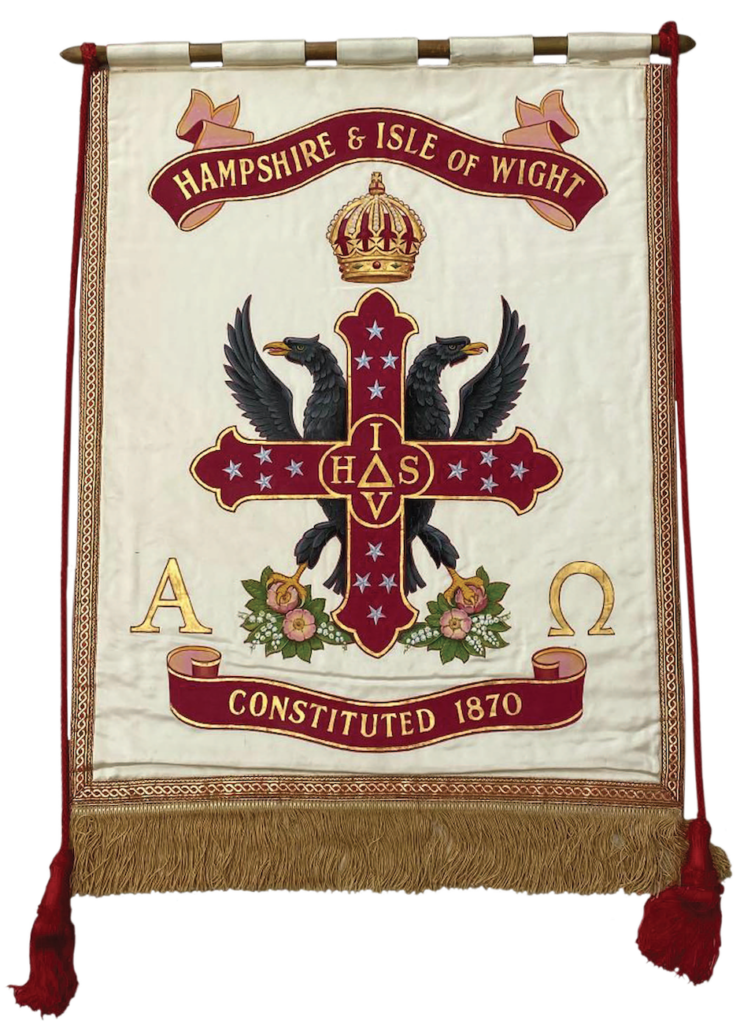
1871-2021
150 Years
A History of the
Masonic & Military Order of
the Red Cross of Constantine
and
the Orders of the Holy Sepulchre
and of
St John the Evangelist
in the Division of
Hampshire & Isle of Wight.
The History
1871 was a year of some notable events:
• The Royal Albert Hall was opened by Queen Victoria.
• Parliament passed the Bank Holidays Act creating 4 annual Bank Holidays.
• The Journalist, Henry Morton Stanley located the missing Scottish Explorer and Missionary, Dr. David Livingstone near Lake Tanganyika in Africa.
• For those who follow the sport played with the funny shaped ball, the governing body for Rugby Union, the Rugby Football Union or RFU, was established in London.
It was in 1871 that another memorable event occurred. It was the year that early glimpses of the Division of Hampshire & Isle of Wight of the Masonic & Military Order of the Red Cross of Constantine emerged. This was just a few months after the consecration of Naval & Military Conclave No 35, on 23rd December 1870 which assembled at the Masonic Hall, 79 Commercial Road, Landport, Portsmouth and just a few years after the foundation of the Order in 1865. The Division has had several name changes over the years but has always included the name of Hampshire. It is sometimes said that Hampshire is the oldest or senior Division but the Year Book lists Kent being constituted in 1870, although it also lists the earliest Kent Conclave being inaugurated in 1873. But because of later boundary changes, as well as some misleading Year Book entries, it is impossible to tell from the Year Books which Division did come first.
There may well be an answer in the early records of the Order, but it is probable though that the creation of Divisions, as in the case of Hampshire, merely followed the inauguration of constituent Conclaves. If that is the case, then of the 34 Conclaves inaugurated before Naval & Military, less than half were in England and Wales. There were seven in London, two in Surrey with the remainder scattered singly in Lancaster, the Lakes, Birmingham, Bristol, Weston-Super-Mare and Pontypool. If that is correct, then one or all the then Divisions to which they owe allegiance would have predated Hampshire.
As a historical point of interest, of the then 19 Conclaves outside England in the British Empire, there were 10 in Canada, 4 in India and 2 each in Scotland and the Channel Islands and 1 in Gibraltar.
Early Years
There is no identifiable record of the Founder of the Division, but early records of the Order show that the driving force behind the initial development was Robert Wentworth Little.
There is no identifiable record of the Founder of the Division, but early records of the Order show that the driving force behind the initial development was Robert Wentworth Little.
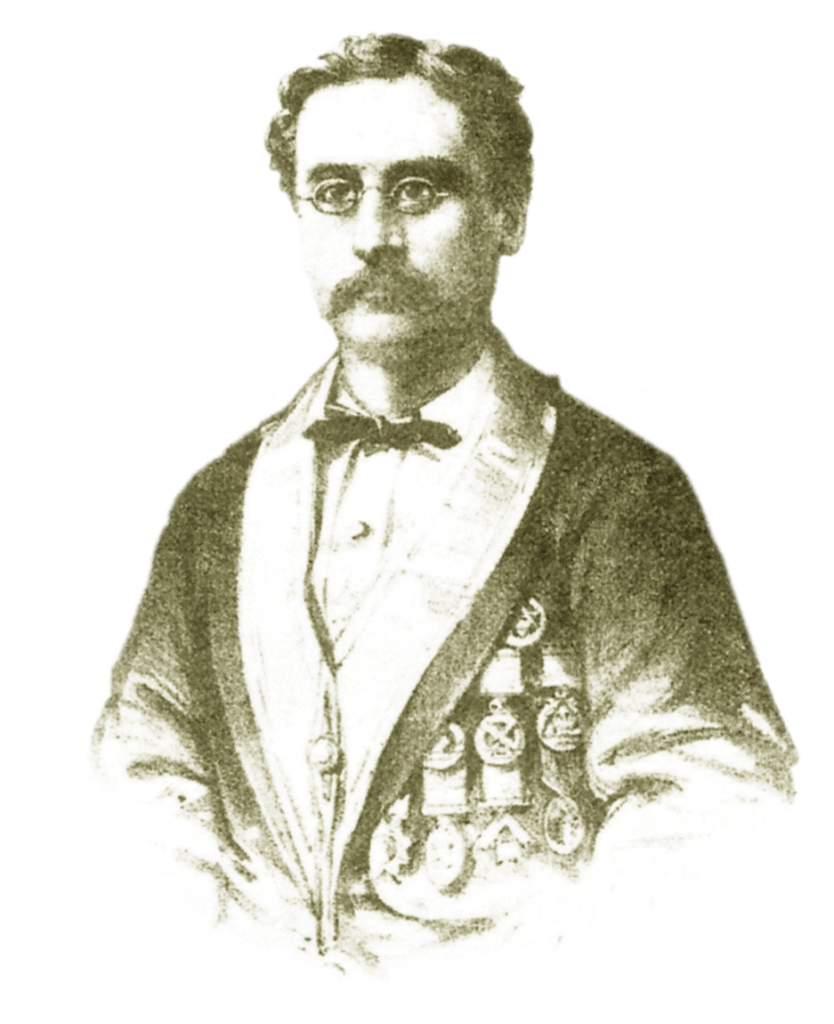
He became actively involved in the foundation of the Order as a whole. He was The Cashier at Freemasons’ Hall and eventually became Grand Recorder. His signature appears on the warrant of Naval & Military Conclave, the first of the Division.
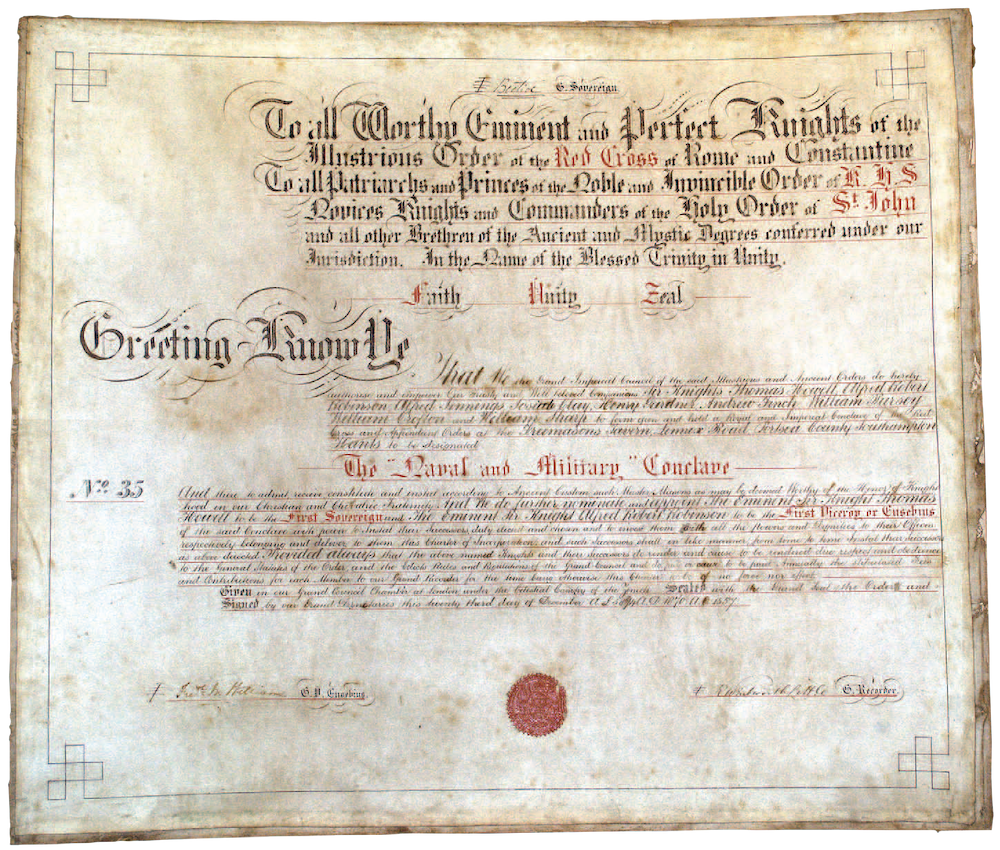

There is little information about the early days of the Division although it is known that the first Intendant-General was Sir Gilbert Campbell, Baronet, but there is no record of a Deputy Intendant-General. Naval & Military Conclave’s earliest minutes in 1877 which make frequent reference to the second Intendant-General who was Surgeon Lt.Col. Charles Knott (later more usually referred to as Dr. Knott).
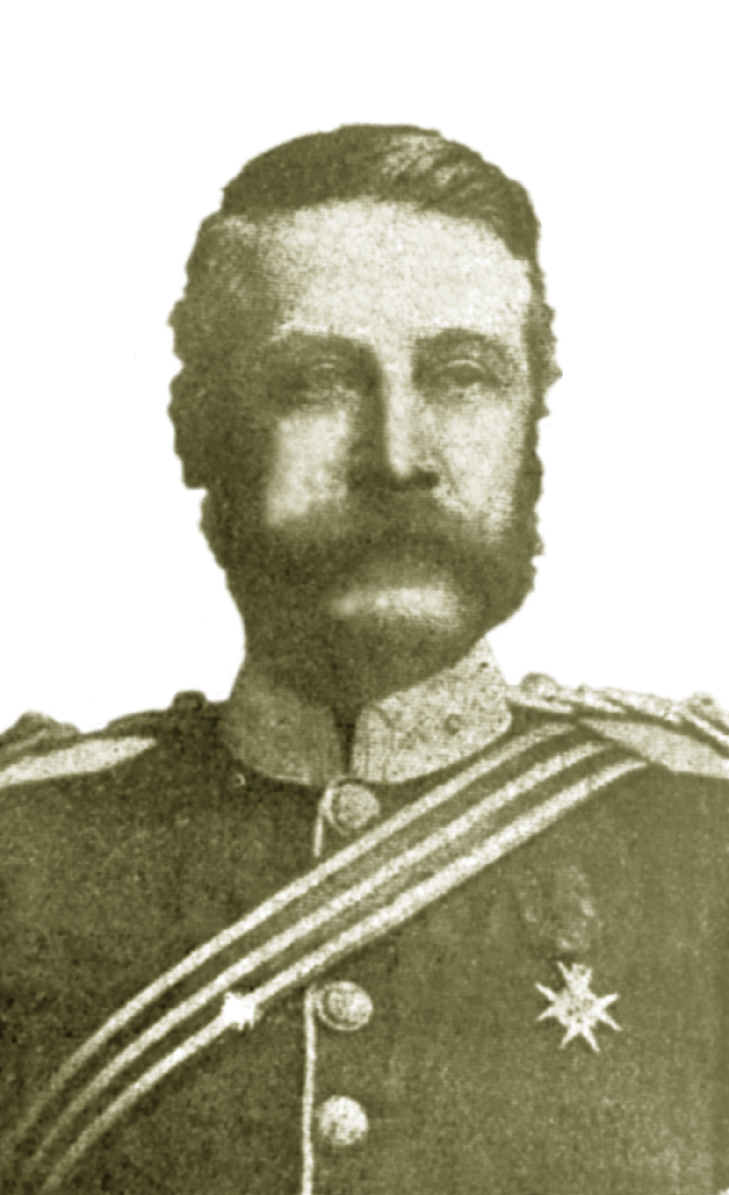
The Deputy Intendant-General was John Clark and with only one Conclave, it is probable that both the Intendant General and his Deputy were members. But despite being regular members of that Conclave and sometimes holders of office, they were accorded the respect that is held today and were probably deferred to by the Most Puissant Sovereign and members.
As a note of interest, the title, ‘Worthy Knights’ was not used then and all were called ‘Sir Knights’, including the Illustrious Sir Knights. It is not known when and why this changed to the title of ‘Very Illustrious Knights’, ‘Illustrious Knights and Worthy Knights’ as it is known today.
There is little information about the activities of the Division during those early years until April 1906. Following a meeting of Naval & Military Conclave, the Prelate, Sir Kt. Hall, pointed out that the then Statutes of the Order required that the Intendant-General must hold a Divisional Grand Conclave at least once in two years. The Intendant-General at the time was still Dr. Charles Knott. A meeting was held between the Intendant-General and Sir Kt. Hall to resolve this matter. The outcome was that the Intendant-General expressed his pleasure to attend the next meeting of the Conclave with the purpose of opening a Divisional Grand Conclave.
25th May 1906
Friday 25th May 1906 was a momentous day; it was the first meeting of the Divisional Grand Conclave. It was held at the Masonic Hall in Landport after a meeting of the Mount Olivet Sanctuary which immediately followed a meeting of the parent Naval & Military Conclave. The business of the Divisional Conclave was commenced, the agenda appearing as items 5,6, & 7 of the Naval & Military agenda.
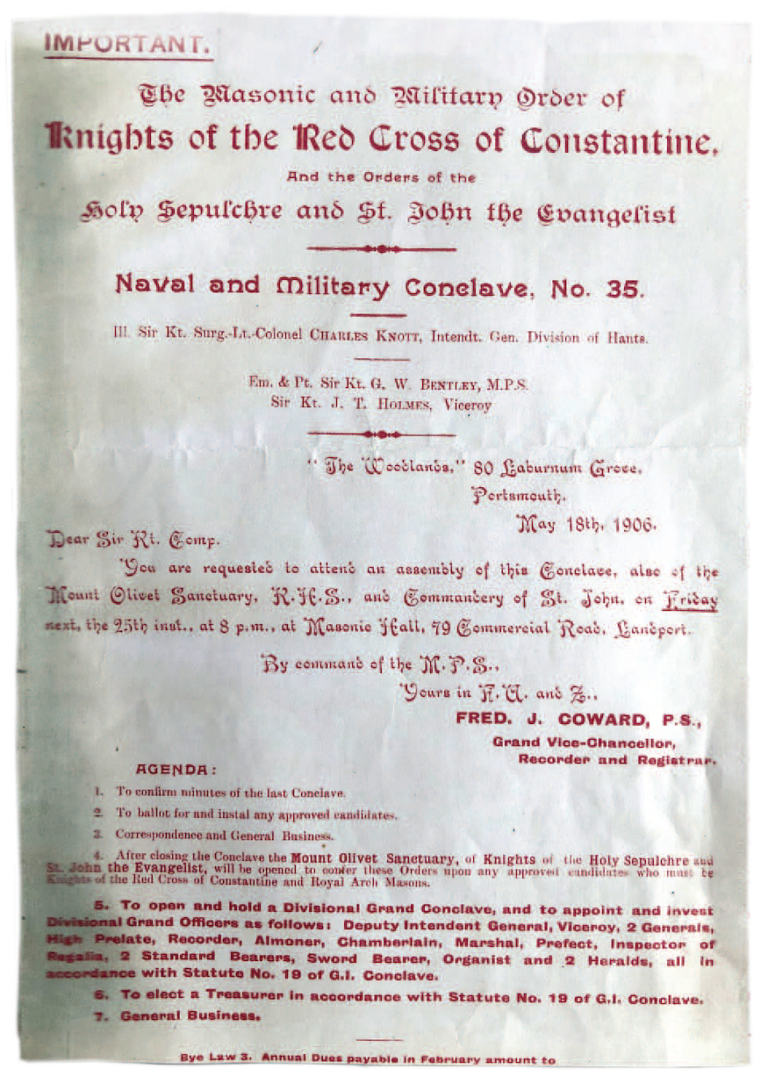
Interestingly, the summons shows the Order entitled as, ‘The Masonic and Military Order of Knights of the Red Cross of Constantine’. This inaugural meeting was opened by the Intendant-General, Dr. Charles Knott, who read out the Order’s Statute No 19 authorising him to convene a Divisional Grand Conclave and appoint Officers. The list of Offices to which Knights were appointed looks much the same as today but then included an Inspector of Regalia and omitted an Orator, Stewards and Sentinel. A Sentinel did appear in 1911 but he was not a member of the Order but referred to as ‘Brother’ and he was paid and usually it was the Landlord of an Inn.
The business of the meeting was simple, open, appoint Divisional Officers, elect a Treasurer and a committee was authorised to prepare Divisional By-laws for approval by the Intendant-General. A couple of weeks after this initial meeting the Grand Recorder of Grand Imperial Conclave, acknowledged the list of Officers and his letter enclosed a receipt for the fee of honour, which was one guinea, now a value of about £108 in today’s money.
As Naval & Military was the only Conclave in the Division it is probable that all the newly appointed Divisional Officers were members of this Conclave.
Naval & Military remained the only Conclave in this new Division for some years and the Divisional meeting followed immediately after an assembly of this Conclave. There was shared responsibility for the administration of the two, there being years when Divisional Grand Conclave was included on the Naval & Military summons, but in later years a separate summons for Divisional Grand Conclave were being issued.
In 1909 Capt. Hubert G. Giles, RN, was appointed as the new Intendant-General for the Division. The Deputy Intendant-General was then Alexander N.G. Howell-Rastrick, who had been in office since 1894. In his address, the new Intendant-General exhorted the Knights present to study the Ritual to enable them to occupy the relevant offices.
After this meeting, the general business of the Division continued without any notable events until 1910 where, after expressions of regret on the passing of King Edward VII, the Divisional Grand Conclave passed a resolution of loyalty to the new Sovereign, George V.
In 1911, there was rejoicing at the Coronation of King George V and later in the meeting the Intendant-General expressed his delight at the enthusiasm of the Sir Knights in improving their knowledge of ritual. This was the year that the appointment of a Sentinel for Divisional Grand Conclave appears.
The minutes for the meeting of the Divisional Grand Conclave in 1912 include expressions of regret at the passing of the Most Illustrious Grand Sovereign, the Earl of Euston and the Intendant-General’s remarks of the notable absence of many hardworking Knights of the Division. Why they were absent? We do not know.
A domestic disaster struck in 1913 where a window left open during a very severe storm, resulted in the loss or damage of all the regalia, including the banner, which was spoilt beyond repair. Whether the banner was that of the Division or the Conclave is unclear because it was the same people at the meetings of both. Fortunately, the Hall Committee, known as the ‘Masonic Club’ was sympathetic and offered support. Either way there is no specific mention of a Divisional Banner until 1956.
In 1915 there were many apologies from those absent on War Duty. This was the first occasion of a direct reference to a ceremony, which was an Installation, having been worked at that meeting. Early references to ceremonies seem somewhat confusing and it is not clear whether the Installations were of Most Puissant Sovereigns or new Knights. For information, the Deputy Intendant-General at the time was Sir John Apsey who was appointed in 1914.
The minutes for 1916 show that the Intendant-General refers to the light duties of his office, presumably of the absence of Knights on War Duty. He did refer to the continued prosperity of the Order in this Division.
At the meeting held in September 1917, the Fees of Honour were revised:
• 1 Guinea for the Deputy Intendant-General.
• 15 Shillings for the Viceroy
• 5 Shillings for all others.
There was specific reference made to Naval & Military still being the only Conclave in the Division and of the shared administrative responsibilities.
There were no notable events recorded for 1918/19.
In 1920, Illustrious Sir Knight, Sir John Apsey, KBE was enthroned as Intendant-General by his predecessor and his patent of appointment was read by the Divisional Recorder. Illustrious Sir Knight, George W. Bentley was appointed Deputy Intendant-General. Just for information of costs at that time, the accounts for 1920/21 show receipts from fees of honour and arrears of í5.3s.6d. The total expenditure for all printing, envelopes and postage was 18s.9d. Total funds amounted to £16.11s.3d.
In 1921/22 a new receipt book cost 16s.6d. The accounts for 1922/23 record the start of regular annual payments of 7s.6d. to the Sentinel. Sadly, the actual account list is lost to time, and we have only sketchy minutes to show these facts.
The Divisional meeting in 1924 saw that the Intendent-General had more weighty matters on his mind than his customary address. He proceeded to read from an ancient ritual the various reasons and objective for the renewal and establishment of the Red Cross Degree:
• Firstly, because of the original intent of the Masonic Institution has been greatly frustrated by the indiscriminate admission of persons of every description and character.
• Secondly, because it unfortunately happened that the sublime branch of our system known by denomination of Christian Masonry has fallen into still worse hands whereby the Test of Faith originally required of the Candidates for initiation has been dispensed with. The rites and mysteries of the Order were being degraded.
• Thirdly, and this indeed is the most powerful reason which has induced them to bring forward this ancient Order, they earnestly wish to counteract the evil designs which the privileges of the Masonic system have been perverted by men of unprincipled character and to combat the enemies of Christianity and social order by the same secret and powerful means which have made use of to affect their purposes.
• The objects of the Red Cross are these: –
• “To draw closer the Masonic union, purify the system of Masonic science, extend its limits and increase its influence by combining such of its professors as are best qualified, by character and principle, respectability and influence, genius and talent to effectuate this great purpose.”
• “To prevent the perversion of its institutions and privileges to objects contrary to and abhorrent from, its original intent.
• “To combat infidelity and treason under whatever form existing and promote by every humble means the social happiness and external welfare of our fellow creatures.”
• It is therefore necessary: –
• “That we observe the greatest circumspection in choice of our members and associates.
• “That we adhere invariably and scrupulously to the principles and constitution of our Order.”
• “That we cultivate a strict and fraternal union among ourselves.”
• “And that we, on all occasions give our decided reference to intellectual and moral excellence over every other consideration whatsoever.”
There is no record as to why the Intendant-General chose to do this at this meeting.
It can only be presumed that there were members who were introducing candidates who were using the Order to further their own means, or members who were bringing the Order into disrepute thus bringing this to the attention and criticism of the outside world. Possibly there could have been a number of resignations. Or it could have been said to remind members of their obligations and to maintain discipline. It is open to debate.
At the Divisional Conclave meeting held on 24th June 1925, the Intendant-General, still Very Illustrious Sir Knight Sir John Apsey, expressed a wish that a new Conclave be formed in the Division. This was to foster a spirit of friendly rivalry in working the Ritual, thus leading to a better performance of the ceremonies. On 12th October 1925, at the next meeting of Naval & Military Conclave, still the only Conclave in the Division at the time and its members forming the Divisional Conclave, 27 of those members petitioned Grand Imperial Conclave to form, ‘The Farnborough Conclave.’ This was to meet on the 4th Saturday of April, May, June and September, at the Tumbledown Dick Hotel, Farnborough. (this is now a drive through burger restaurant.) The petition was granted.
30th October 1926
The 30th of October 1926 was a landmark date in the history of the Division. All Knights had been summoned to attend a meeting of the Divisional Grand Conclave at Portsmouth. There they received the Right Illustrious Grand Viceroy, Charles Herbert Perram. MD. Assisted by members of the Grand Imperial Conclave, he consecrated the Farnborough Conclave & Sanctuary No 168. The Grand Viceroy enthroned Illustrious Sir Knight Harold Francis Green as the first Sovereign and consecrated Very Eminent Sir Knight George Weeks as Viceroy. On a historical note, the ceremony of Consecration had been delayed from May because of disruptions caused by the 1926 General Strike.
By these times, the Divisional Conclaves were being held as separate meetings. The general business of the Division continued through the years of 1927 to 1931 with nothing of note to speak of. In 1932 the Divisional meeting was moved to Farnborough hosted by the Farnborough Conclave but returned to Portsmouth for the meeting in 1933.
It was in the year of 1934 that the number of members of the Division is first noted. This was found in a report of The Divisional Grand Recorder & Registrar. Then the total membership was 80. It was in that year that the Viceroy of Naval & Military Conclave, was tragically killed in a motor accident. There are no details as to his name.
The meeting for 1935 was due to be held in Farnborough, but, as the date clashed with the Aldershot Tattoo at which so many members would be on duty, it was decided to be held in Portsmouth. It was held in Farnborough the following year.
1937 saw the first visit of the new Grand Sovereign, Dr. Charles Herbert Perram, to the Division. The accounts showed the balance to be the sum of 8d. Farnborough Conclave is referred to with its number, 168 for the first time. It is reported that Naval & Military Conclave had a marble tablet erected at the Masonic Hall in Commercial Road, noting the names of Past & Present Sovereigns. This is still in the former Masonic Hall at 10 Guildhall Walk, Portsmouth. (see image on page 33)
The Divisional meeting of 1939 saw the bank balance standing at the sum of 2s.8d. More reference was made to Conclave membership numbers: Naval & Military’s strength was 60 and 17 at Farnborough. It is reported that due to enemy action, there was no Divisional Grand Conclave for the years 1940/41, but the Intendant-General did appoint Officers in name. In November of 1942 there was a meeting at which the minutes for the 1939 meeting were approved and the bank balance soared to a staggering height of í2.5s.0d. The meeting in 1943 was conducted by the Divisional Grand Viceroy owing to the absence of both the Intendant-General and his Deputy, though we do not know why.
As a point of interest concerning Masonic activities during the years of the Second World War, it was found that on 4th September 1939 an edict from Mark Masons’ Hall reported that His Majesty’s Government had ordered that until further notice, all Masonic meetings were to be suspended. A later undated letter issued from Mark Masons’ Hall informed all administered Orders that this instruction had been rescinded and that meetings could be resumed after consultation with Provincial Authorities. There were however conditions which included:
• Meetings might not be held on Sundays.
• Morning Dress should be worn.
• Meetings should be arranged to take place as early as possible in the day.
• After-proceedings, where held, should be brief and simple.
Relaxation of some Masonic rules were also given e.g.:
• Permission to cancel meetings even though notice had already been given.
• Meeting dates could be postponed for up to seven days without dispensation.
• Meeting days could be changed temporarily without changing the By-laws.
• Masters could be elected and installed at the same meeting.
• Grand and Provincial dues in respect of members absent on National
Service were to be paid by their Lodges. I presume this might have applied to all the Masonic Orders.
Continuing with the war years, a letter from the Grand Sovereign was received at the Divisional meeting in March 1944 referring to the resignation of the then Intendant-General, Illustrious Knight James Jenkins and the appointment of Illustrious Knight W. T. Fellows. Travel difficulties made it impossible for the Grand Sovereign to attend and perform the ceremony. Details of a shortened ceremony were sent for this to be performed in one of the Conclaves, but there are no records available as to which Conclave held the ceremony or who presided.
The Divisional Grand Conclave meeting for 1945 was presided over by the Divisional Treasurer due to the Intendant General having died previously. In 1946, the Grand Sovereign attended that year’s meeting to install the new Intendant General, Illustrious Knight Harold Francis Green. The Deputy is listed as R. Parker. It is not known what name the ‘R’ refers to. The minutes of the meeting record that the Grand Marshal had caused the word ‘Grand’ to be dropped from the name of the annual assembly. The same minutes record the introduction of an annual membership fee of 6d per member to supplement the only other income of fees of honour.
In 1947 the Divisional meeting was hosted by Farnborough Conclave, and it was noted that the Divisional strength was 83, a number bolstered by 15 new members to Naval & Military Conclave during the past year. The Intendant General had real praise for the standard of ritual that was performed and was pleased to note that both the outgoing Sovereign and Viceroy of Farnborough Conclave had installed their successors. He hoped this practice would continue. In 1948, at which time the annual Divisional meetings alternated between Portsmouth and Farnborough, it was ruled that the Sentinel of the host Conclave would be the Divisional Sentinel for the coming year. The use of ritual books at meetings was remarked on as gradually fading out.
Moving forward to 1950 saw the Division expand into Sussex to welcome Rose of Sussex Conclave who met at Littlehampton. It was noted that Naval & Military had decided to have a full-page supplement in the Provincial Grand Lodge Yearbook and following this it was agreed that the Division should do likewise.
2nd June 1951: Hampshire & Sussex
The annual Divisional meeting on Saturday 2nd June 1951 was held at the Masonic Hall, Alexandra Road, Farnborough. This was the first time in the history of the Division that the new title of Hampshire & Sussex is seen. The Divisional Recorder read a letter received from the Grand Recorder dated 24th April that year, stating that the Most Illustrious Grand Sovereign had been pleased to grant the petition of Rose of Sussex Conclave No 196 and that it be embodied in the Division of Hampshire and that from 1st May 1951 the Division will be known as ‘Hampshire & Sussex’. The 35 members of Rose of Sussex increased the Divisional strength to 126.
A special assembly of the Division was held in February 1952 where the Grand Sovereign attended to enthrone a new Intendant-General, James Herbert Pegg. The Deputy Intendant-General was Hon. Major Cyril Trist Gasking MD. For the first time the summons notes that dark morning dress or uniform should be worn, along with white gloves and swords. On a side note: It was during 1951/2 that Farnborough Conclave moved to meet at Aldershot as it was a more suitable place. Rose of Sussex Conclave was congratulated by the Intendant-General as being the best furnished Conclave in the Division and was delighted that a most beautiful Divisional Sword was presented by Worthy Knight Hollick and dedicated by Worthy Knight Reverend C H Mosse. The meeting in June 1952, presumably to mark the change in the Divisional title, was held in Worthing. The minutes record the rank of Worthy Knight, probably for the first time and there was hope for a new Conclave at Chichester. The Order was noted as progressing overseas in Australia and New Zealand.
The Divisional meeting of June 1954 was held for the first time at the Masonic Hall at Aldershot. Divisional funds were low, so in addition of an appeal to increase funds, annual dues from members were increased to one shilling. 1955 saw the change of name of Farnborough Conclave to Border Conclave. The ‘Sir’ element of ranks seems to have disappeared and Viceroys seem settled on being called Eminent Knight.
Moving forward to the Divisional meeting I959 a new banner, presumably in the name of Hampshire & Sussex, was presented and dedicated with much ceremony. At this time, the total membership for the Division was 136. 72 were in Naval & Military Conclave, 36 in Border and 28 in Rose of Sussex. The Alms collection amounted to í2.2s.0d. In 1962 the Intendant-General declared that he was looking forward to a new Conclave being formed in Sussex. By 31st December 1962, the strength of Naval & Military Conclave was down to 56 with Border and Rose of Sussex being 27 and 47, respectively. During that year, the new Conclave, Rose of England No 227 was consecrated and would meet at St. Leonards on Sea. There were no new appointments to Grand Rank in 1964 as the Grand Sovereign had extended the period between eligibility to 3 years after leaving the chair to give more value to such ranks.
On 21st October 1972, saw the addition of Rose of St. Mary Conclave, No 274 to the Division. It was consecrated by the Intendant-General Very Illustrious Knight Lancelot E.C. Peckover assisted by the Deputy Intendant-General, Very Illustrious Knight, Capt. O. Anderson, at the Masonic Hall, Eastbourne.
1973: Hampshire & Isle of Wight
Records of this period conclude with the Divisional meeting of 1964 by which time the Division’s four Conclaves had a combined strength of 154. It was confirmed the annual assemblies would rotate between Hampshire and Sussex. Our Divisional sword is a memorial of the union with Sussex.
We now see the Division with five Conclaves, three of them in Sussex. It could have been this situation that caused the three Sussex Roses to leave in 1973 and go off to form the new Sussex Division. Hampshire however was not to be outdone, because by then it had established its own two Roses, Rose of Wessex No 236 in 1966 and Forest Rose No 265 in 1971.
The Division reverted back to being called, The Hampshire Division, until 1974 which saw the consecration of St. Boniface Conclave No 287 at Seaview on the IOW. The Division’s title was reconstituted as Hampshire & Isle of Wight. Following the death of Very Illustrious Knight, Lancelot E.C. Peckover, The Intendent-General for the newly resuscitated Division was to be Illustrious Knight Chandos John Washington.
Moving forward, the Division grew with the consecration of Holy Rood Conclave, No 319, at Fareham in 1977. The Constituting Sovereign was the Intendant-General, Very Illustrious Knight, C. J. Washington, the Deputy Intendant-General was Very Illustrious Knight Commander T. R. Smart. The Grand Sovereign at the time was Most Illustrious Knight Brigadier C.B.S. Morley. The Grand Viceroy was Right Illustrious Knight Reverend Canon Richard Tydeman.
The Divisional meeting for 1977 was held on 30th April at Lymington under the Banner of St. Boniface Conclave. There the Intendant-General said that the future meetings would be held under the Banner of different Conclaves and that the Sentinel should be of that Conclave.
Our history next takes us to 1987 where we see the Division broadening its horizon to Wiltshire with the addition of Cathedral Conclave No 398, which assembled at Salisbury in Wiltshire. Despite this. the Division still retained the title of ‘Hampshire & Isle of Wight’ It was on Tuesday 27th January that year, that the Grand Sovereign attended an enthronement meeting held at the Masonic Centre at Kings Court, Chandlers Ford.
The Grand Sovereign was now Most Illustrious Knight Reverend Canon Richard Tydeman. He was accompanied by officers of Grand Conclave and was pleased to enthrone Right Illustrious Knight, Commander Ronald Albert Champion R.N. as the new Intendant-General for the Division. The Deputy was Very Illustrious Knight John Rowntree Elgie.

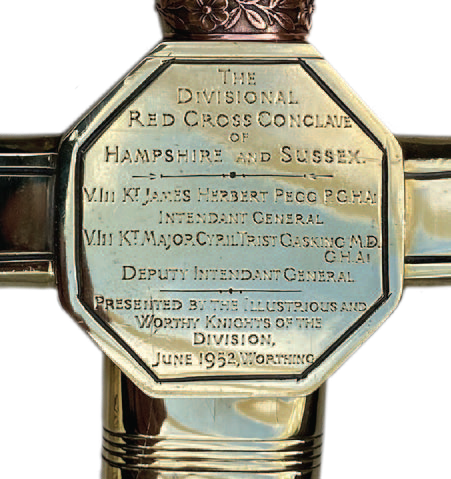
1989: Sepulchre Guard
In 1989, the Intendant-General introduced a Divisional Sepulchre Guard on a trial basis, which later became a permanent feature. The duties of the Guard included escorting the Intendant-General and his Deputy on visits to Conclaves in the Division to form with swords the Arch of Steel on the entrance and departure from the Conclave meetings and to act as the Sepulchre Guard when Appendant Orders ceremonies were performed at Sanctuaries and Commandries. The first Captain of the Guard was Puissant Knight, Major C.B. Hubbard. He was given authority to recruit to the Guard and submit a design for a tie to be worn by them. Later, a Guard collarette was introduced.
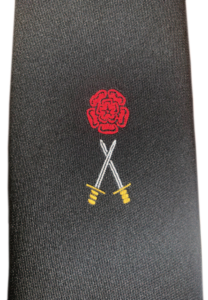
The meeting on 23rd June 1990 was held at Ryde under the Banner of St. Boniface Conclave. The Intendant-General declared that his practice of visits to Divisional Conclaves (4 times a year by himself and 3 by the Deputy Intendant-General in alternate years) did not work. As an experiment he will make an official visit every year. He would be accompanied by as a full team of active Divisional officers as could attend and hoped that he would thus be enabled to keep in closer contact with the Conclaves. By visiting in this manner, it would turn each visit into a gala event for the Conclave concerned.
The next date of note is Saturday 26th June 1993 when the Divisional Conclave met at the Freemasons’ Hall, 10 Guildhall Walk, Portsmouth. This meeting saw The Grand Sovereign accompanied by officers of Grand Conclave attend to enthrone a new Intendant-General, Illustrious Knight, Lt. Colonel Gerald Southwell, the Deputy was Very Illustrious Knight, George Nichols. The number of Conclaves in Hampshire and Isle of Wight remained at seven until Saturday 28th October 1995, where at the Masonic Centre, Winchester, the Intendant-General was the Constituting Sovereign for the consecration of King Aethelwulf Conclave No 437.
1998: Hampshire, Wiltshire & Isle of Wight
The Divisional summons for Saturday 27th June 1998 saw the addition of Wiltshire to the Divisional title due to Cathedral Conclave meeting at Salisbury. So now it was to be known as the Division of Hampshire, Wiltshire and Isle of Wight. Listed among the Conclaves of the Division was St. Peter and St. Paul Conclave No 450, consecrated on 19th September 1997 meeting at Winchester.
31st March 2000 saw the consecration of Mystic Rose Conclave No 464 meeting at Woolston.
There was a special Divisional meeting held at the Masonic Centre at Winchester on Thursday 29th May 2003. The Intendent-General, Right Illustrious Knight Lt. Col. Gerald Southwell along with the Deputy, Illustrious Knight R.B. Freemantle, welcomed the Grand Sovereign, Most Illustrious Knight Commander Ronald Albert Champion, R.N. and officers of Grand Imperial Conclave. The King Aethelwulf Sanctuary and Commandery No 437 was opened by The Right Reverend Prelate and Most Eminent Commander, Most Puissant Knight Roger Bricknell, who was Commander for the ceremony and taking the office of Seneschal was one Eminent Knight, named S. Groeger (in brackets on the summons – Steve).
Saturday 28th June 2008 saw the Division meet for the first time at Brook House, Botley under the Banner of Cathedral Conclave. The Divisional meetings have been held at Botley since that date. It was noted at this meeting that the Divisional strength was 222 and with multiple memberships at 277.
At the Divisional meeting on 27th June 2009, the Intendant-General was pleased to appoint Illustrious Knight Roger Charles Bricknell as the Deputy Intendant-General.
Thursday 9th December 2010 was the day that Illustrious Knight Roger was enthroned as the new Intendant-General of the Division. The enthronement was carried out by the Grand Sovereign, Most Illustrious Knight Richard Victor Wallis JP. Illustrious Knight, Jamieson Beaney, better known as Jim, was appointed as Deputy Intendant-General until 2013 when he was succeeded by the now Very Illustrious Knight John Lawrence (Larry) Peer MBE. Then on 23rd June 2018 Illustrious Knight, Steven Groeger was appointed to that office.
The Division in Kenya
In 2011 the Division went International. Right Illustrious Knight, Gerry Southwell was approached by a member of Cathedral Conclave, W.Kt. Andrew Brass to the effect that some RA masons in Nairobi, Kenya, wished to form a RCC Conclave there with him as the Consecrating Officer. Authority was given by Grand Imperial Conclave and after many meetings and much email traffic with Nairobi, plans were made. But this was not just a consecration ceremony, the Founders first had to be installed into the Red Cross then into the Appendant Orders.
Dispensation was given to allow W.Kt. Brass to be consecrated as Eusebius at St. Peter and St. Paul Conclave. He made travel arrangements and left for Kenya to supervise procurement of equipment. So, the consecrating team which included Right Illustrious Knights, Roger Bricknell, Gerry Southwell, Illustrious Knights, Roy Rudling, Bruce Dyson, Angus Hannagan, Richard Dunleavy, Ian Glister, Bryan Little, Larry Harding and joined by Stephen Hindes from Mumbai and Ron Pool from South Africa, first installed 16 candidates into the RCC and the next day, 11 candidates for the ceremony of the Appendant Orders. Two days later on Saturday 29th January 2011, the Divisional team carried out the consecration of the East Africa Conclave No 508 at Freemasons Hall, Nyerere Road, Nairobi.
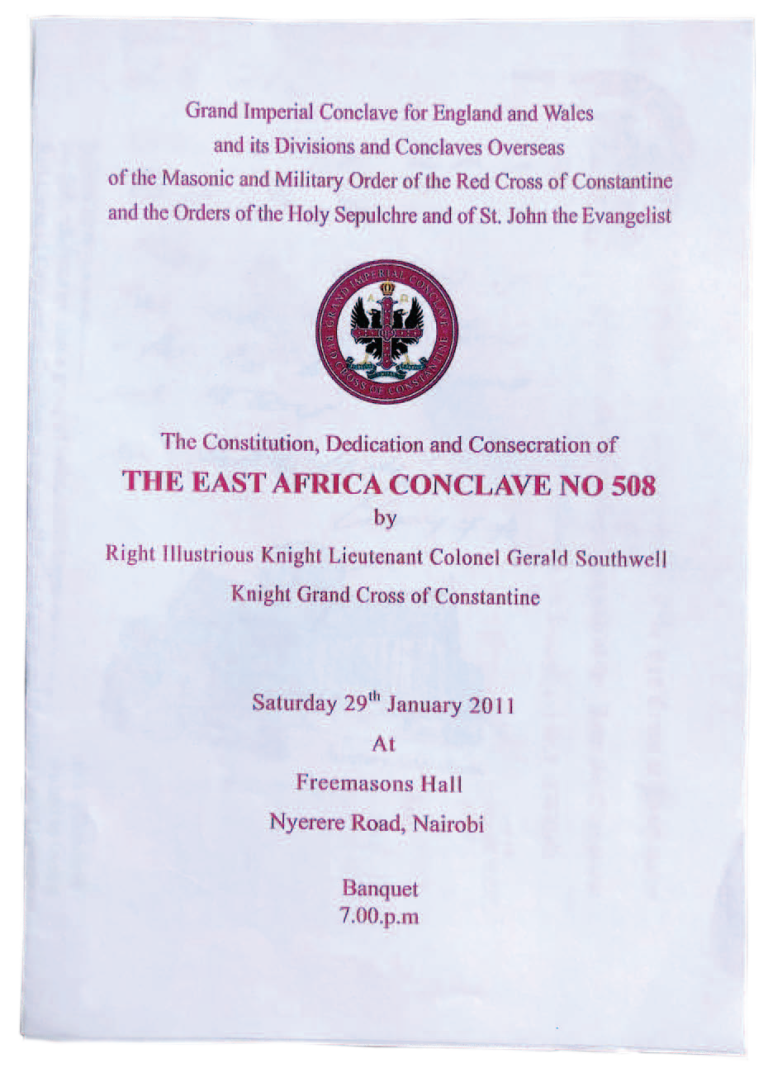
October 2012 - Present
11th October 2012 saw the consecration of The Milvian Bridge Conclave No 515, named after the Bridge that saw the famous battle where Constantine defeated the rival Emperor, Maxentius. The Conclave met and still does, at Andover.
April 2014 was another landmark time for the Division, it was then that Wiltshire transferred to Dorset to become the Dorset & Wilshire Division. We saw the loss of Cathedral Conclave to that new Division, and we now once again became the Division of Hampshire & Isle of Wight. Luckily, the original banner which had been kept was now once again in use.
Worthy Knights, we have come a long way during the last 150 years, the first glimpses in 1871 with only the one Conclave, Naval & Military. Through the first and second world war years. The addition of Border Conclave, the reconstituting to include Conclaves in Sussex, the addition of The Rose of Wessex and Forest Rose Conclaves. Then back to Hampshire Division. The addition of St. Boniface Conclave enabling the reconstituting to Hampshire & Isle of Wight. Soon we were joined by Holy Rood Conclave, Cathedral Conclave, King Aethelwulf Conclave. Reconstituting to Hampshire, Wiltshire & Isle of Wight. We saw the addition of St. Peter & St. Paul Conclave, Mystic Rose and Milvian Bridge Conclaves. Then the loss of Cathedral Conclave and Wiltshire to us becoming what we are today, Hampshire & Isle Wight.
What of the future? Right Illustrious Knight Roger Bricknell has handed over the Division into the care of Right Illustrious Knight Steven Groeger with Very Illustrious Knight Kevin Todd MBE as the Deputy Intendant-General, and despite the setbacks our Division and Freemasonry have suffered in general due to the strange days of the coronavirus pandemic this Proud Division of Hampshire & Isle of Wight will march on to greater heights.
Em.Kt. Gerry Thurgar
Naval & Military Conclave No 35

